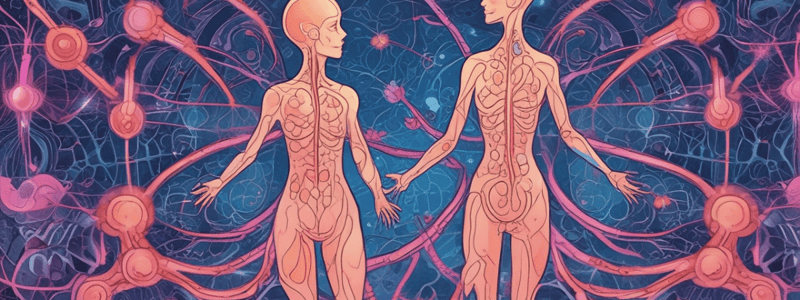Podcast
Questions and Answers
What is the primary consequence of alkylation on DNA synthesis?
What is the primary consequence of alkylation on DNA synthesis?
- Inhibition of topoisomerase
- Stimulation of DNA transcription
- Induction of DNA repair mechanisms
- Formation of covalent bonds between DNA strands (correct)
What is the primary effect of nitrosoureas on bone marrow?
What is the primary effect of nitrosoureas on bone marrow?
- Enhanced differentiation of stem cells
- Severe effect on replicative capacity (correct)
- Stimulation of replicative capacity
- No effect on replicative capacity
During which phase of the cell cycle are cells most susceptible to alkylating agents?
During which phase of the cell cycle are cells most susceptible to alkylating agents?
- Late G1 and S phase (correct)
- M phase
- G2 phase
- Early G1 phase
Which of the following statements is true about methotrexate?
Which of the following statements is true about methotrexate?
What is a common side effect of platinum-based DNA synthesis inhibitors?
What is a common side effect of platinum-based DNA synthesis inhibitors?
What is a mechanism of action of 5-FU?
What is a mechanism of action of 5-FU?
What is the primary mechanism of action of alkylating agents in cancer treatment?
What is the primary mechanism of action of alkylating agents in cancer treatment?
What is the common side effect of cyclophosphamide and methotrexate?
What is the common side effect of cyclophosphamide and methotrexate?
What is the characteristic of platinum-based DNA synthesis inhibitors?
What is the characteristic of platinum-based DNA synthesis inhibitors?
Which of the following is not a route of administration for methotrexate?
Which of the following is not a route of administration for methotrexate?
Which type of cancer is commonly treated with platinum-based DNA synthesis inhibitors?
Which type of cancer is commonly treated with platinum-based DNA synthesis inhibitors?
What is the primary mechanism of action of carboplatin?
What is the primary mechanism of action of carboplatin?
What is the primary mechanism of action of doxorubicin?
What is the primary mechanism of action of doxorubicin?
Which of the following is NOT a side effect of doxorubicin?
Which of the following is NOT a side effect of doxorubicin?
What is the common mechanism of action of plant derivatives such as vinca alkaloids and taxanes?
What is the common mechanism of action of plant derivatives such as vinca alkaloids and taxanes?
What is the effect of etoposide on the cell cycle?
What is the effect of etoposide on the cell cycle?
Which of the following is a natural source of etoposide?
Which of the following is a natural source of etoposide?
What is the primary mechanism by which fluorouracil prevents DNA synthesis?
What is the primary mechanism by which fluorouracil prevents DNA synthesis?
What is the effect of Fludarabine on DNA synthesis?
What is the effect of Fludarabine on DNA synthesis?
What is the primary mechanism by which Cytarabine inhibits DNA synthesis?
What is the primary mechanism by which Cytarabine inhibits DNA synthesis?
What is the primary mechanism by which cytotoxic antibiotics affect nucleic acid structures?
What is the primary mechanism by which cytotoxic antibiotics affect nucleic acid structures?
What is a common side effect of fluorouracil and Cytarabine?
What is a common side effect of fluorouracil and Cytarabine?
What is the primary mechanism by which Penostatin inhibits DNA synthesis?
What is the primary mechanism by which Penostatin inhibits DNA synthesis?
Lomustine is a nitrogen mustard.
Lomustine is a nitrogen mustard.
Methotrexate is a purine analogue.
Methotrexate is a purine analogue.
Thymidylate synthetase is inhibited by 5-FU.
Thymidylate synthetase is inhibited by 5-FU.
Carboplatin has more side effects compared to cisplatin.
Carboplatin has more side effects compared to cisplatin.
Methotrexate can be administered through subcutaneous injection.
Methotrexate can be administered through subcutaneous injection.
Intra-strand linking and crosslinking occurs between N7 & O6 of adjacent adenines.
Intra-strand linking and crosslinking occurs between N7 & O6 of adjacent adenines.
Cisplatin is not used to treat solid tumours.
Cisplatin is not used to treat solid tumours.
Platinum-based DNA synthesis inhibitors are highly myelotoxic.
Platinum-based DNA synthesis inhibitors are highly myelotoxic.
Carboplatin is an oral medication.
Carboplatin is an oral medication.
The primary mechanism of action of alkylating agents is to inhibit DNA synthesis.
The primary mechanism of action of alkylating agents is to inhibit DNA synthesis.
Doxorubicin inhibits topoisomerase I.
Doxorubicin inhibits topoisomerase I.
Vinca alkaloids target microtubules.
Vinca alkaloids target microtubules.
Etoposide is derived from the bark of the Pacific Yew tree.
Etoposide is derived from the bark of the Pacific Yew tree.
Taxanes are derived from the periwinkle plant.
Taxanes are derived from the periwinkle plant.
Doxorubicin is given orally.
Doxorubicin is given orally.
Etoposide binds to the complex formed between DNA and topoisomerase.
Etoposide binds to the complex formed between DNA and topoisomerase.
Fluorouracil is a nucleoside analogue that binds to DNA polymerase and inhibits its action.
Fluorouracil is a nucleoside analogue that binds to DNA polymerase and inhibits its action.
Cytarabine is a pyrimidine nucleoside analogue that inhibits purine metabolism.
Cytarabine is a pyrimidine nucleoside analogue that inhibits purine metabolism.
Fludarabine is metabolized to a monophosphate form that inhibits active site of DNA polymerase.
Fludarabine is metabolized to a monophosphate form that inhibits active site of DNA polymerase.
Penostatin inhibits adenosine deaminase, leading to increased purine metabolism.
Penostatin inhibits adenosine deaminase, leading to increased purine metabolism.
Cytotoxic antibiotics, such as anthracyclines, are recommended for use in combination with radiation.
Cytotoxic antibiotics, such as anthracyclines, are recommended for use in combination with radiation.
5-FU is an analogue of 2’-deoxycytidine.
5-FU is an analogue of 2’-deoxycytidine.
Flashcards are hidden until you start studying
Study Notes
Cancer Development and Treatment
- Cancer development involves the integration of cellular signaling pathways and cell death mechanisms
- Principles of cancer development include:
- Cellular signaling involved in cancer development and cell death
- Specific drug mechanisms
- Treatment strategies related to cancer development
- Tailoring treatment strategies based on distinctive features of normal and cancerous cells
DNA Synthesis Inhibitors
- Inhibit one or more metabolic pathways involved in DNA synthesis
- Types of DNA synthesis inhibitors:
- Folate antagonists (e.g. Methotrexate)
- Inhibit dihydrofolate reductase
- Competitive inhibitor with higher affinity than dihydrofolate
- Side effects: bone marrow depression, epithelial/mucosal layer damage
- Pyrimidine analogues (e.g. 5-FU)
- Inhibit thymidylate synthase
- Activate DNA damage response
- Side effects: myelotoxicity, epithelial/mucosal layer damage, nausea and vomiting
- Purine analogues (e.g. Fludarabine)
- Metabolized to a trisphosphate form
- Inhibit active site of DNA polymerase
- Side effects: myelosuppression
- Nucleoside analogues (e.g. Cytarabine)
- Analogue of 2'-deoxycytidine
- Inhibit DNA polymerase
- Side effects: bone marrow depression, epithelial/mucosal layer damage, nausea and vomiting
- Folate antagonists (e.g. Methotrexate)
DNA Damaging Agents
- Alkylating agents:
- Form covalent bonds in DNA, impeding replication
- Intra-strand linking and crosslinking
- Most susceptible in late G1 and S phase of cell cycle
- Examples: nitrogen mustards (e.g. Cyclophosphamide), nitrosoureas (e.g. Lomustine)
- Platinum-based agents:
- Water-soluble
- Slow IV or infusion
- Used in solid tumors (e.g. testes, ovary)
- Side effects: highly nephrotoxic, low myelotoxicity, vomiting and nausea
- Examples: cisplatin, carboplatin, oxaloplatin
Cytotoxic Antibiotics
- Affect nucleic acid structures
- Main mechanism: DNA modification
- Examples: anthracyclines (e.g. Doxorubicin), bleomycin
- Side effects: nausea and vomiting, loss of hair, myelosuppression, cardiotoxicity
Plant Derivatives
- Naturally occurring products
- Often target microtubules
- Types: vinca alkaloids (e.g. vinblastine), taxanes (e.g. paclitaxel), others (e.g. etoposide)
- Side effects: myelosuppression, nausea and vomiting, alopecia, etc.
Studying That Suits You
Use AI to generate personalized quizzes and flashcards to suit your learning preferences.



